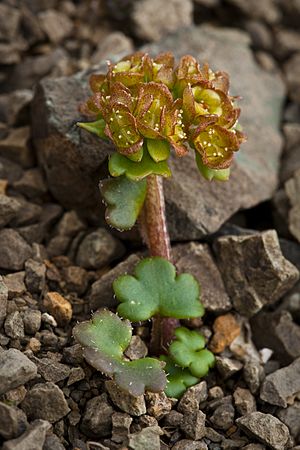Wright's golden saxifrage facts for kids
Quick facts for kids Wright's golden saxifrage |
|
|---|---|
 |
|
| Scientific classification | |
| Genus: |
Chrysosplenium
|
| Species: |
wrightii
|
| Synonyms | |
|
Chrysosplenium alternifolium var. wrightii (Franch. & Sav.) Sutô |
|
Chrysosplenium wrightii, also known as Wright's golden saxifrage, is a special plant found naturally in northwestern North America and northeastern Asia. This plant loves cold places! You can find it growing in the tundra or along the banks of streams. It can even grow high up in the mountains, sometimes as high as 2,300 meters (about 7,500 feet) above sea level. Its home includes places like British Columbia, Yukon, and Alaska in North America, and the Kamchatka Peninsula and eastern Siberia in Russia.
Scientists first described this plant in 1878. The first samples were collected near the Sea of Okhotsk. This area was part of Japan at the time, but it is now part of Russia.
Contents
What is Wright's Golden Saxifrage?
Wright's golden saxifrage is a type of herb. An herb is a plant that does not have a woody stem. This plant spreads and grows using special stems called stolons. Stolons are like runners that grow along the surface of the ground, helping the plant create new plants nearby.
How Does it Grow?
When it's time to flower, Wright's golden saxifrage sends up flowering stalks. These stalks can grow up to 16 centimeters (about 6 inches) tall. Each stalk can have a group of up to 30 flowers! This group of flowers is called a cyme.
What Do Its Flowers Look Like?
The flowers of Wright's golden saxifrage are very colorful. They can be yellow, purple, or orange. Often, they have pretty purple spots, which makes them even more interesting to look at!
Different Types of Wright's Golden Saxifrage
Just like some animals have different breeds, some plants have different types or varieties. Scientists have found two main types of Wright's golden saxifrage. These types are accepted by a group of plant experts called The Plant List.
- Chrysosplenium wrightii var. beringanum: This type is found on St. Paul Island in Alaska.
- Chrysosplenium wrightii subsp. saxatile: This type grows in Russia.

